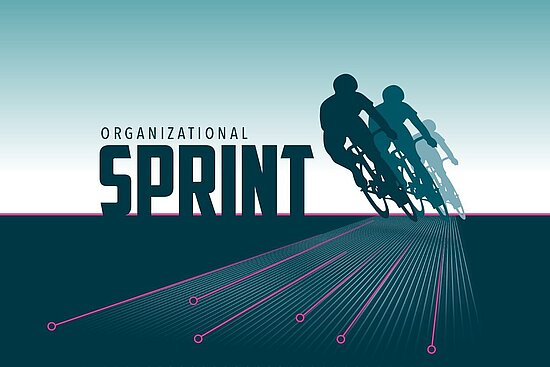
Operating Model: Productive division of labor is the basis of an efficient organisation
The collaboration of many requires a sensible division of labour: clarity about tasks and roles and efficient core processes that are aligned with the strategic goals of the organisation. This effective setup is one of the most important prerequisites for an organisation's performance.
However, how well the division of labour works in practice also depends on how clear common goals are, how effective leadership and collaboration are and how well the right talent is found, developed and retained. We integrate these aspects into a holistic approach that is visibly more effective than traditional approaches.
Challenges and solutions
We support our clients when the set-up of their organisation is an obstacle to better performance. When there are deficits in terms of speed, agility or customer focus, when there are duplications and inefficiencies, when strategic course changes also require adjustments to the organisation. Depending on the problem, we work on the interfaces of cooperation in the existing organisation or provide support in the design of new organisations and complete restructuring. We use proven methods and tools to develop customised solutions for our clients.
Examples from our consulting practice
If you want to further develop the set-up of your organisation and improve management and collaboration, we should talk. Together we can discuss how we can make your organisation more successful with a clear business orientation, a holistic approach and a focus on implementation.
Our experts look forward to hearing from you!
Organisational structure: What is important for companies
The simplest form of establishing a division of labour is an organisational structure in which clearly described tasks are assigned to specific parts of the organisation. But what exactly does this mean and how can you optimise your company's organisational structure?
How-to: What does a successful reorganisation look like?
Teams are better than individuals for countless reasons and are the cornerstone of every organisation. Nevertheless, we experience dysfunctional teams time and again, especially management teams. Why is this and how can teams develop systematically?
Transformation - not without HR!
HR is increasingly becoming a central player in transformation processes. It is no longer just about efficiency and professional HR work, but about making a strategic contribution to the transformation of the organisation.
Restructuring and systemic organisational development
Restructuring and systemic organisational development are crucial processes for any company that wants to successfully meet the challenges of a constantly changing market. Successful restructuring begins with a thorough analysis of existing company structures and processes. It is essential to develop a clear understanding of the company's actual needs and specific situation. The focus here is on identifying and optimising inefficient processes in order to make the organisation more effective and responsive.
Systemic organisational development goes one step further by viewing the company as a holistic system. Not only structural but also cultural aspects are taken into account. The aim is to adapt the company structure to meet both external market conditions and internal requirements. This type of development promotes cross-departmental communication and co-operation, which is essential for overcoming complex challenges and for sustainable success. By combining restructuring measures and systemic organisational development, a company can increase its agility, boost employee motivation and hold its own on the market in the long term.
Matrix organisation and functional organisation
The matrix organisation and the functional organisation are two basic structural models that can be used in companies, depending on requirements and context. The matrix organisation is a combination of functional and project-based structure. It is often used in larger companies that manage a large number of competences and projects. This form of organisation is particularly effective when flexibility and efficient use of resources are required, as it allows employees from different departments to be brought together in project-based teams.
In contrast, the functional organisational structure is clearly divided into different departments. Each department focuses on a specialised area of responsibility, such as marketing, finance or human resources. This model is particularly suitable for companies that have clearly defined and specialised areas of responsibility. The functional structure promotes clear responsibilities and in-depth expertise in specific areas, which can lead to high quality work results.
Both forms of organisation have their advantages and disadvantages:
- While the matrix organisation offers flexibility and can enable effective use of resources, it can also lead to complexity and conflict if responsibilities between functional and project-related roles are unclear.
- The functional organisation, on the other hand, offers clear responsibilities and promotes expertise, but in some cases can be less flexible and lead to silo thinking.
The choice of the appropriate organisational form ultimately depends on the specific goals, size and culture of the company.
Agile organisational development and agile organisation
Agile organisational development involves applying agile methods and principles to the entire organisational structure. An agile organisation is characterised by flexibility, adaptability and the ability to react quickly to change. In such a structure, managers are less hierarchically organised and act more as coaches or mentors for their teams. Such a management structure promotes a culture of self-organisation and personal responsibility, which in turn increases the company's innovative strength and speed of response.
Setting and achieving goals: OKRs and shared decision making
Objectives and Key Results (OKRs) are a powerful tool for achieving objectives, helping you to define and pursue clear, measurable goals. Combining OKRs with the concept of Shared Decision Making creates a transparent and participative decision-making process. This promotes the involvement and commitment of all employees and supports the alignment of the entire team with the overarching corporate goals. By including different perspectives, strategic decisions within the company are not only more well-founded, but also more widely accepted.
Automation of processes in the organisational structure
The automation of business processes is an essential part of modern corporate structures. It plays a decisive role in increasing efficiency and effectiveness in various departments. By automating processes, routine tasks can be simplified and accelerated, leaving employees more room for creative and strategic tasks. This leads to an optimisation of the entire company structure by using resources more efficiently and streamlining processes.
The advantages of automated processes are manifold. They range from time savings and error reduction to improved data analysis and decision-making. In larger companies, automation supports coordination between different departments and helps to maintain a flat and flexible organisational structure. In such a structure, open and cross-departmental communication is easier and responsiveness to the actual needs of the market is improved.
Your individual organisational consulting
There are many factors to consider when designing your corporate structure, from the functional structure to agile organisational structures and the automation of processes. Our experts support you in developing a corporate structure that meets the specific requirements and objectives of your company. We offer customised advice aimed at designing an efficient, flexible and future-oriented corporate structure.
Our consulting covers a range of competencies, from the introduction of flat hierarchies and the promotion of open communication to the implementation of agile and decentralised corporate structures. We help you to train the managers in your company so that they can effectively promote cross-departmental communication and collaboration.
Contact us now for an individual consultation to optimise your corporate structure and prepare your company for future challenges. Let's work together to design an agile, efficient and functional organisational structure for you.
FAQs on the topic of corporate structure
Do you have any questions or are you interested in exploring a possible collaboration with undconsorten? Get in touch with us - we will help you further.








